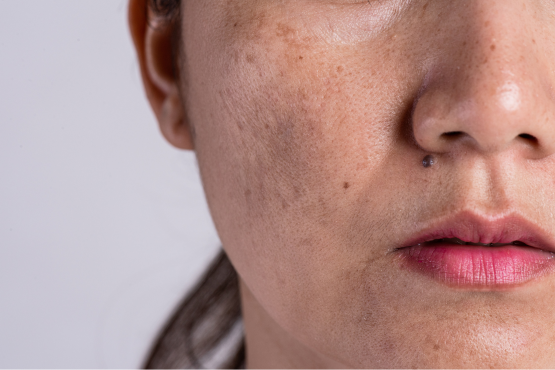Pigmentation on the face is a common concern for many people, particularly for those with darker skin tones. Pigmentation occurs when there is an overproduction or uneven distribution of melanin, the pigment that gives our skin its color. In this article, we will discuss the various causes of pigmentation on the face and how to prevent and treat it.
Causes of Pigmentation on the Face
Sun Exposure
One of the most common causes of pigmentation on the face is sun exposure. When the skin is exposed to the sun, it produces more melanin to protect itself from the harmful UV rays. Over time, this can lead to an uneven distribution of melanin, resulting in dark spots or patches on the face.
To prevent sun-induced pigmentation, it is important to use a broad-spectrum sunscreen with an SPF of at least 30, even on cloudy days. Wearing a hat or using an umbrella can also provide additional protection from the sun.
Hormonal Changes
Hormonal changes can also cause pigmentation on the face, particularly in women. Pregnancy, menopause, and the use of birth control pills can all lead to an increase in melanin production, resulting in dark spots or patches on the face.
To prevent hormonal pigmentation, it is important to maintain a healthy lifestyle and manage stress levels. Hormonal therapy may also be recommended by a doctor.
Ageing
As we age, the production of melanin in our skin decreases, leading to a loss of skin color and the appearance of age spots. These spots are more common in areas that have been exposed to the sun, such as the face, hands, and arms.
To prevent age-related pigmentation, it is important to protect the skin from the sun and maintain a healthy lifestyle. Using a retinoid cream may also help to reduce the appearance of age spots.
Inflammation
Inflammation can also cause pigmentation on the face. This can be the result of acne, eczema, or other skin conditions that cause inflammation and irritation.
To prevent inflammation-induced pigmentation, it is important to treat any underlying skin conditions and maintain a healthy skincare routine. This may include using gentle cleansers and moisturizers and avoiding harsh chemicals or exfoliants.
Genetics
Genetics can also play a role in pigmentation on the face. Some people are more prone to developing pigmentation due to their genetic makeup.
To prevent genetic pigmentation, it is important to maintain a healthy lifestyle and protect the skin from the sun. Treatment options may include laser therapy or chemical peels.
How to Treat Pigmentation on the Face
Topical Treatments
Topical treatments are often the first line of defense against pigmentation on the face. The most effective skincare products that fight pigmentation contain one or more of these ingredients:
- BRIGHT Oléoactif®: Clinically tested to deliver 18.5x skin lightening in just 4 weeks & fewer dark spots in just 56 days.
- Bakuchiol: A plant-based alternative to retinol/retinoids that can help to reduce the appearance of dark spots and even out skin tone.
- Vitamin C: An antioxidant that can help to brighten the skin and reduce the appearance of dark spots.
Professional Treatments
Regular visits to a dermatologist or skincare professional can also help to prevent pigmentation on the face. These professionals can recommend preventative measures and treatments based on individual skin type and concerns.
Some of the most popular professional skincare treatments for pigmentation on face include:
Laser Therapy
Laser therapy is a popular treatment option for pigmentation on the face. This treatment works by targeting the melanin in the skin and breaking it down. The body then naturally eliminates the pigment over time.
Chemical Peels
Chemical peels involve applying a chemical solution to the skin to remove the outermost layers. This can help to reduce the appearance of dark spots and even out skin tone.
Microdermabrasion
Microdermabrasion involves using a special tool to gently exfoliate the skin and remove dead skin cells. This can help to reduce the appearance of dark spots and improve skin texture.
Preventative Measures for Pigmentation on the Face
Sun Protection
One of the most important preventative measures for pigmentation on the face is sun protection. It is important to wear a broad-spectrum sunscreen with an SPF of at least 30, even on cloudy days. Wearing a hat or using an umbrella can also provide additional protection from the sun.
Healthy Lifestyle
Maintaining a healthy lifestyle can also help to prevent pigmentation on the face. This includes eating a balanced diet, getting enough sleep, and managing stress levels. Drinking plenty of water can also help to keep the skin hydrated and healthy.
Skincare Routine
Establishing a healthy skincare routine can also help to prevent pigmentation on the face. This may include using gentle cleansers and moisturizers, avoiding harsh chemicals or exfoliants, and using products that contain antioxidants or skin-lightening agents.
In conclusion, pigmentation on the face is a common concern that can be caused by a variety of factors. Sun exposure, hormonal changes, ageing, inflammation, and genetics can all contribute to pigmentation on the face.
However, there are many treatment options available, including topical treatments, laser therapy, chemical peels, and microdermabrasion.
Preventative measures, such as sun protection, maintaining a healthy lifestyle, establishing a skincare routine, and regular visits to a skincare professional, can also help to prevent pigmentation on the face.
With the right treatment and preventative measures, it is possible to achieve a clear and even skin tone.



